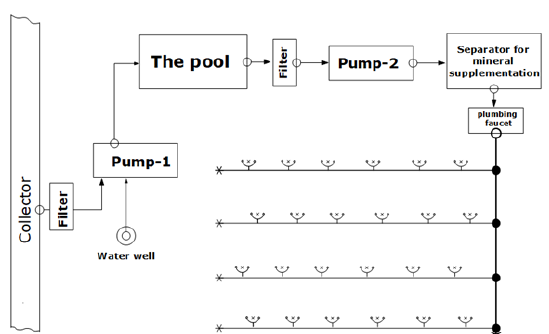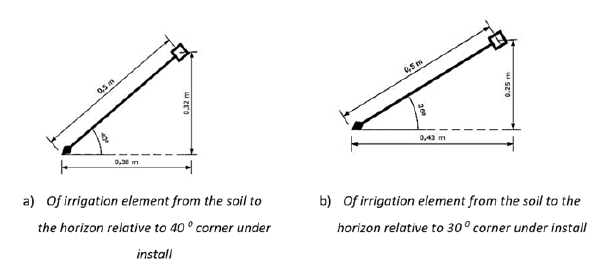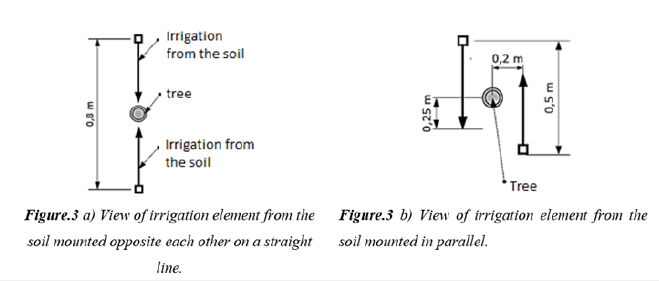- Submissions

Full Text
Modern Concepts & Developments in Agronomy
Usage Of Irrigation Elements By Means Of Water-Efficient Technology In Irrigating Intensive Apple Gardens Through Soil And Dynamics Of Seeping Moisture
Juraev FU*, Karimov GH and Urinov EF
“Tashkent Institute of Irrigation and Agricultural Mechanization Engineers” National Research University. Bukhara Institute of Natural Resources Management, Uzbekist
*Corresponding author:Juraev FU, “Tashkent Institute of Irrigation and Agricultural Mechanization Engineers” National Research University. Bukhara Institute of Natural Resources Management, 200109 Bukhara, Uzbekistan
Submission: April 07, 2022;Published: June 08, 2022

ISSN 2637-7659Volume11 Issue 1
Abstract
In this article we are on the side created gardens irrigation water thrifty methods one soil from within irrigation improved technology parameters and in the soil the dynamics of the movement of moisture learn on experiments results were showed. Created soil from within irrigation of the element to the horizon relatively installation corner α=30°,40° inclined installed in the scheme of the soil active layer wetting of moisture capillary and gravitational forces affected movement studiedand the height of the wetting contour over time H, the radius of the width L, the contour area 3 values of the irrigation norm Wm3/ha were determined accordingly.
Keywords: Wood; Installation angle; Soil; Humidifier; Height; Width; Size; Pipe; Humidity
Introduction
One of the most effective methods of irrigation is in-soil irrigation. The peculiarity of this
irrigation method is the fact that water enables to improve the optimal water, air, heat and
nutrient regimes by moistening the soil where the roots of the plant are located, not directly
on the soil surface, but on the active layer of soil. The first experiments on irrigation from
the soil (in-soil irrigation) were conducted in 1849 in France, and in 1913 in the United
States for the first time, using humidifier pipes from ceramic drainage pipes for irrigation.
In Russia research on sub-irrigation began in the 1920s with the idea of a vacuum and
automatic irrigation from the soilsystem by VG Kornev. In-soil irrigation systems differ mainly
in the following principles: the principle of water infiltration into the soil and the method of
construction of in-soil humidifiers [1-3]. According to productive work techniques it can be
divided into three subgroups.
A. Vacuum soil irrigation.
B. Irrigation from unpressurized soil
C. Irrigation from under the soil under pressure.
Not only availability of irrigation system, nature of soil moisture, and the amount of items expenditure are highly dependable to the device of sub-irrigation drippers such as ceramic pipers, hollow bricks, tiles, woods and so on; but also it highly differs in terms of discharge [3].The development of industry has allowed the widespread use of polymeric materials. Due to the sub-irrigation equipment being made from polyethylene and its availability of installing special water drippers, in-soil irrigation could give the opportunity of using polyethylene pipes which charge reasonable price.
Many Russian and foreign researchers have studied the nature of sub-irrigation, its technique and effectiveness in their research. The scientists are VP Ostapchik, MS Grigorov, NR Khamraev, VG Laboda, VG Karpiy, VG Kornev, J Philip, W Mitchell, G Toumon, D Edwards, J Robins, W Gardner and others [4-7]. All studies carried out by them have proven that using this technique much more agricultural crops and fruits have been yielded compared to the other types of irrigation methods. Soil moisture reserves in the soil are formed as a result of its interaction with plants and weather conditions [8,9]. Quantitative indicators of the amount and movement of moisture in the soil among the most essential factors characterizing the water regime that is formed in the soil. Extensive work on the study of the laws of moisture distribution in irrigation from the soil was carried out by VG Kornevym, AA Bogushevskim, VP Ostapchikom, VI Bobchenko, VR Ridigerom, LE Chernyshevskoy, AA Alesashenko and other researchers [10-14].
Purpose and Materials of the Study
The proposed irrigation technology is the latest science-based innovation in the organization of intensive garden irrigation from the ground, water-saving technology, which has given its positive effect in its application. Based on the fact that there is almost no technology of local irrigation of the root system with intensive irrigation of gardens in the country, and the purpose of the study, a schematic diagram of irrigation from the soiltechnology was developed (Figure 1). In this case, surface or groundwater is pumped into the pool, after a certain time it is cooled, filtered, sucked with the help of the 2nd pump, mineral fertilizers are mixed using a separator, sent to the main pipe under atmospheric pressure 1.5- 2, then to the irrigation element from the soil An average of 3-3.5 liters of water per hour leaks from irrigation element from the soil.
Figure 1:The design scheme and main parameters of the irrigation element from the soil working part work in the following order: Irrigation element from the soil is made of polyethylene pipe,ensures that the water coming from the main pipe leaks at the same rate.

Figure 2:Constructive angles and dimensions when installing an in-soil irrigation device.

When using irrigation from the soil technology, it is possible to install 2 to 4 irrigation element from the soil around a tree, depending on soil-climatic conditions, garden seedling species, and tree age. Studies have shown that at different values of the installation angle relative to the irrigation element from the soil horizon, the α size limits of the soil moisture area may vary. In order to achieve an optimal wetting area, the contours of wetting under laboratory conditions of the irrigation from the soilelement were studied in the variants with mounting angles α=30° ,40° (Figure 2). The recommended dimensions for installing around a irrigation element from the soil tree are as follows (Figure 2).
Installation of irrigation element from the soil around the tree
a) The figure shows a structural drawing of an irrigation
element installed opposite each other in a straight line, with a
total irrigation length of 0.8m when installed around the tree
on both sides
b) Irrigation element from the soil in parallel at a distance of
0.2m from the tree trunk is installed on both sides so that the
wetting area is wider than the gap (Figure 3a & 3b).
Figure 3:Dimensions for installing irrigation element from the soil around a tree.

Results and their Analysis
When irrigation element from the soil is the recommended installation angle around the tree α=30°and α=40°when, the values of the wetting contour height H, width radius L, contour area Sm3 and the irrigation norm Wm3/ha were determined over time.In the irrigation options given in the table , the soil pre-irrigation moisture in option 1 was 180 m3/ha at an installation angle of 70% relative to the ChDNS α=30°. In option 2, the soil pre-irrigation moisture, 70% relative to the ChDNS, at the installation angle α=40°, the s irrigation rate was 175m3/ha. In option 3, the soil pre-irrigation moisture, 80% of the ChDNS, at the installation angle α=30°, the s irrigation rate was 125m3ha. In variant 4, the soil pre-irrigation moisture content was 80% relative to the ChDNS, and the irrigation rate at the installation angle α=40° was 115m3/ha. It can be seen that the irrigation element from the soil, installed at a small angle to the horizon, has a wide wetting area and low water consumption [15-17] (Table 1).
Table 1:

Results and Discussio
Intensive irrigation of gardens is intended to save water, that is, to meet the plant’s demand for water with low water consumption, not to use too much water, to prevent water evaporation.
Conclusion
Researchers have proven that in-soil irrigation can reduce water consumption by 2-3 times compared to surface irrigation and by 15-20% compared to drip irrigation. Also, rows of seedlings in intensive orchards prevent the growth of weeds, ensuring the normal growth and development of seedlings, creating conditions for harvesting, as well as preventing them from various diseases [18,19].
References
- Bezolyuk BV (1991) Architectonics of the root system of yabloni in dependence on the mode of droplet growth. Sadovodstvo, vinogradarstvo, Vinodelie Moldavii 2: 20-22.
- Vyvodyanitsky (1981) The root system of the apple tree under irrigation. Horticulture, viticulture and winemaking in Moldova 12: 21-22.
- Juraev FO, Karimov GH (2015) Techniques and technology of intensive underground irrigation of gardens. Development of science and technology. Bukhara Institute of Engineering Technology, Uzbekistan, 2: 33-39b.
- Grigorov MS (1978) Osobennosti podpochvennogo orosheniya.Sb. state: Texnika i sposoby poliva selskoxozyaystvennyx kultur, Novocherkassk, Russia, 15(1): 50-55.
- Bobchenko VI (1976) Characteristics podpochvennyx uvlajniteley. Sb Oroshenie, M VNIGiM 40: 86.
- Boyko AP, Sirotenko OD (1976) Mathematical description of the process of water absorption by the root system of plants. Trudy IEM 8(67): S24-S28.
- Borovoy EP (1999) Nauchnoe obosnovanie tehniki i tehnologii vnutripochvennogo orosheniya kormovyx kultur, p.48.
- Borovoy EP, Vetrenko EA (2003) Nauchno-eksperimentalnoe obosnovanie VPO yablonevogo sada. Materialy mezhdunarodnoy nauchno-prakticheskoy konferentsii "Problems APK", posvyashchennoy 60th anniversary of Pobedy pod Stalingradom, Volgograd, Russia, pp. 201-203
- Vetrenko EA (2002) Raschet vlagoperenosa pri VPO s uchetom otbora vlagi kornyami rasteniy. Materialy Vtoroy mejdunarodnoy nauchnoprakticheskoy konf. Actual problems of ecology in the conditions of the modern world, Maykop, Russia, pp. 67- 69.
- Shumakov BB, Gostishchev DP (1976) On the effectiveness of intraperitoneal growth of polyethylene pipes with small perforations of small diameter. Vestnik s/x nauki 11: 93-97.
- Bedanokova S, Yu Zadacha (2005) Koshii nelokalnaya kraevaya zadacha dlya obobshchёnnyx drobnyx ostsillyatsionnyx uravneniy, Bedanokova S, Dokl Adyg (Circassian) Mejdunar Acad Science T 8(1): 9-15.
- Gostishchev DP (2016) Matematicheskoe modelirovanie vlagoperenosa pri VPO / DL Gostishchev, DS Valiev // Evraziyskoe Nauchnoe Ob'edinenie 2 No3 (15): S. 165-171.
- Golovanov AI (2018) Vzaimosvyaz mezhdu plodorodiem pochv i vodnym regime pri vаrashchivanii kartofelya na dernovo-podzolistyx pochvax. AI Golovanov, VV Pchelkin, VO Gerasimov, OM Kuzina, Nauchnaya jizn 6: S. 85-94.
- Grigorov MS (2005) Osobennosti peredvijeniya vlagi v pochve pri vnutripochvennom oroshenii. MS-296 Journals of Agrarian Science 5: p.15.
- Dobrachev YuP (2014) Method of obosnovaniya obespecheniya vodnymi resursami obektov gidromelioratsii pri razrabotke SKIOVO. Yu P Dobrachev, AL Buber, LV Kireycheva, et al. V sborn.: Kompleksnye melioratsii - sredstvo povysheniya produktivnosti selskoxozyaystvennyx zemel. - FGBNU VNIIGiM im. ANKostyakova, pp. 54-66.
- Dobrachev Yu P (2016) Models rosta i razvitiya rasteniy i zadacha povysheniya urojaynosti . YuP Dobrachev, ALSokolov Prirodoobustroystvo 3: 90-96.
- Shkura VN (2017) About uchete pochvennyx vodno-fizicheskix characteristic at determining parameters of contour kapelnogo uvlajneniya pochvy. VN Shkura, AS Shtanko. Scientific magazine Rossiyskogo NII Problem Melioratsii 4(28): 137-153.
- Shkura, VN (2017) About uchete pochvennyx vodno-fizicheskix characteristic at determining parameters of contour kapelnogo uvlajneniya pochvy, VN Shkura, AS Shtanko. Scientific magazine Rossiyskogo NII Problem Melioratsii 4(28): 137-153.
- Jurayev F, Karimov GH (2015) Organization of drip irrigation in desert areas. AGRO ILM. Journal of Agrarian and Economic Science 6(38): 48-49.
© 2022 Juraev FU. This is an open access article distributed under the terms of the Creative Commons Attribution License , which permits unrestricted use, distribution, and build upon your work non-commercially.
 a Creative Commons Attribution 4.0 International License. Based on a work at www.crimsonpublishers.com.
Best viewed in
a Creative Commons Attribution 4.0 International License. Based on a work at www.crimsonpublishers.com.
Best viewed in 







.jpg)






























 Editorial Board Registrations
Editorial Board Registrations Submit your Article
Submit your Article Refer a Friend
Refer a Friend Advertise With Us
Advertise With Us
.jpg)






.jpg)














.bmp)
.jpg)
.png)
.jpg)










.jpg)






.png)

.png)



.png)






